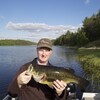Hudson's Bay Company History

“Found it!”
The first things you notice as you climb the clay riverbank are the rhubarb, lilac bushes, and forget-me-not plants – not native to the boreal forest. Unlike much of the land in Northeastern Ontario, someone once lived here and planted these things.
These flowers aren’t far from a breathtaking vista – a towering gorge that echoes with the sounds of the roaring water as it plunges into a pool far below. In the background you can hear the sound of heavy machinery working in a wilderness environment; it is the noise of progress near New Post Falls.
Because of the narrow gorge, there is a great deal of mist in the air. One of the most scenic and accessible but relatively unknown waterfalls is changing and going back to what it once was. Construction has started on the new hydroelectric dam that will affect the flow of water plunging over the crest. But that was last month’s story. Now we go further back in time, to another place near the falls.
Genealogy is a curiosity for most, a hobby for many, and an obsession for some. There is the practical side of genealogy such as tracing ownership or cultural identification. There are also the philosophical aspects of human curiosity; the desire to carve out a place for one's family in the larger historical picture, a sense of responsibility to preserve the past for future generations, and a sense of self-satisfaction in accurate storytelling. The abandoned graveyard at the former Hudson’s Bay Company (HBC) outpost is now wilderness, but it wasn’t always this way. Through the tall grass and dense new growth, there it is – a cemetery holding clues to the past.
The Historic Context
Canada seems to have more geography than history but the HBC is a huge part of what we know about our heritage. For generations fur traders scratched out a living in the North American wilderness. Here in Northeastern Ontario, the HBC dominated the landscape through a commercial empire and a network of outposts. At one time the HBC encompassed an area ten times that of the Holy Roman Empire.
The employees of the HBC lived with our “first peoples” and the impact of their wrongdoings is well documented. As Peter C. Newman wrote in his 1985 book, Company of Adventurers, it included accepting the fact that “liquor was part of their necessary operations,” becoming “citizens of the New Land, in the early years mating with the Indian tribes with whom they traded,” and “more serious medical complaints [such as] ‘county disorder’ (a form of fever combined with catarrh) and syphilis.”

Google searches often lead only to generalities, but good library and journalism skills are far more satisfying and generally result in finding the information I was looking for. In this case it’s the Hudson's Bay Company Archives from the Provincial Archives of Manitoba. Marie Reidke in Winnipeg put me on to a scanned copy of HBCA PP5288 – New Post History: Hudson's Bay Company Post on the Abitibi River, Ontario. Many thanks to her opening my eyes to the discoveries that followed.
The New Post site was operational from 1857 until 1924, half way between Moose Factory and Abitibi Lake. This post possessed four buildings: a factor’s (manager) residence, a second house occupied by a Native family, a general trading store, and a storehouse. “A dozen tents or teepees indicated that about twelve hunters were dependent on the post.” You begin to get stuck within the world of words.
From the turn of the last century, visiting geologist to New Post, William Arthur Parks, writes, “New Post is the only trading station of the HBC on the Abitibi and is the only place where supplies of any kind can be obtained from Fort Abitibi and Moose Factory. Mr. Jobson’s son, the factor in charge, has a flourishing garden in which are turnips, onions, potatoes, corn, cabbage, lettuce, and radishes all doing well. Early red potatoes were rotting on the ground, but white varieties do well; 300 bushels were grown here last year. Corn will ripen some years, but it fails on other occasions.
Mr. Jobson has several head of cattle, the winter fodder for which is gathered by the Indians, and consists of the marsh grass abundant along the river. The soil is fine, argillaceous (Definition—Consisting of or containing clay) in places. As an example of the vagaries of the rivers, Mr. Jobson informed me that in the spring of 1897 the water rose to the foundation of his house, a distance of 29 feet. The Indians attached to the post are rapidly succumbing to the attacks of consumption and scrofulous (Definition—having a rundown appearance or morally contaminated) disease and owing to the decrease of partridge and rabbit are sometimes at sore straights for food. As the rabbit fails the lynx also disappears for want of prey, while the beaver is almost hunted out in this district.”
A 1970s excerpt from a report by Woodland Heritage archaeologist, John Pollock (a Temiskaming Shores resident), it states, “Indians (sic) who traded at New Post had a large system of family hunting territories that covered the east of the Abitibi River.” You now have historic impressions and interpretations, by visitors and professionals, and snapshots or tidbits of life there.
The Research
There are a number of compelling headstones and unmarked graves at the New Post site, but there is one – and only one – iron fence and iron marker at the site; it is a headstone with the following: “Sacred to the memory of Alexander McLeod - a native of Caithness Scotland - who died at New Post Hudson’s Bay – 3rd September 1885 –aged 60 years- and Jane Turner – his wife – who this life at New Post Hudson’s Bay – 19th January 1886 –aged 50 years – blessed by the name of the Lord – erected by their surviving children – who deeply deplore their loss.” Who is Alexander McLeod – someone special? Caithness is one of the Orkney Islands where most of the HBC—called “Bay men”—originated from. Their new existence was fairly bearable when compared to their homeland and besides that, they now had jobs. The pursuit to find out begins. It takes a while and the hunt for information is only sustainable by interest. The surname McLeod is as common to Cree First Nations in the north as is Turner and Linklater, stemming from HBC employees. The real problem was to sort out the masses of names.

George eventually became a carpenter and assumed a variety of company positions. When his father died he returned to New Post to pick up his siblings. His home, known as the “McLeod House” is an Ontario Heritage Site (1982) on the east side of Museum Street within the Centennial Park Museum, a designated Canadian Heritage Site at Moose Factory.
He returned to New Post as the factor in 1917 where he brought his wife Isabella and their 16 children. He left a long-lasting commemorative plaque to his mother and father and completed 47 years of service with the HBC. He retired to a farm near Huntsville in 1923 and died in 1925. It has to be a testimonial to the Scottish-Calvinism’s hard work ethic.
Although this cemetery was abandoned, it is now “disused,” a heritage cemetery classification. In the pursuit to learn more about their culture, the Cree First Nation, Taykwa Tagamou (pronounced tay-kwa tag-a-moe) and proponents of the new generating station recently cleared the brush away from the plots. At the same time Northern Spirit Adventures, in costume, bring visitors, many of whom are internationals, on day trips in voyageur canoes. “We have already made twelve trips this year and I think this trip is popular because we really make a point that Northern Ontario is a real gem,” said outfitter and owner Andre Bernier. “This trip is full of history with the Aboriginals people and the fur trade. We touch all areas of heritage and nature interpretation making sure our clients live an adventure that they won’t forget. The highlights are the HBC cemetery and New Post Falls.”
Go for a Visit

At the dam there are a couple of monuments, a Rudyard Kipling poem embossed on bronze plaques, and a dynamic view. You may not be a fan of dams but at certain times of the year the volume of water is comparable to Niagara Falls on a more horizontal plane than a vertical drop. It is impressive; the rock walls are 46 m (150’) above the riverbed. There is a good boat launch here and you could travel 13 km to New Post Falls and visit the former Hudson’s Bay Company outpost; WGS 84 17 U E462036 N5535851 or N49° 58.428’ W081° 31.767’.
Found it alright, and a great deal more. You develop an appreciation for genealogy; it is a puzzle with pieces somewhere in the box of the past. Chances are many of our ancestors had to overcome considerable personal hardship in their lives. The knowledge that our forefathers had great inner strength can be a powerful motivator for anyone trying to understand their place in the world. You stare at the headstone and wonder about one’s life and different journeys. Two people at the same destination, one leaves enriched, one stays forever.
Recommended Articles
The Seven's Best Hikes, Biking Trails and Lakes

7 Best Spots to Check Out in The Seven

Budget Bliss: Explore Northeastern Ontario Without Breaking the Bank

Bring Your Fam!

Time to Unwind: 6 Spa Havens to Discover In The Seven
5 Amazing Places to SUP in Northeastern Ontario

5 Amazing Bike Rides to Discover

Northern Lights in Northeastern Ontario

Northeastern Ontario's Best Pride Festivals

Fish for one of the World's Rarest Species of Trout

An Insider's Guide to Manitoulin Island

6 Small-Town Gems to Explore in Northeastern Ontario

11 Best Things to Do in Kapuskasing, Ontario






























